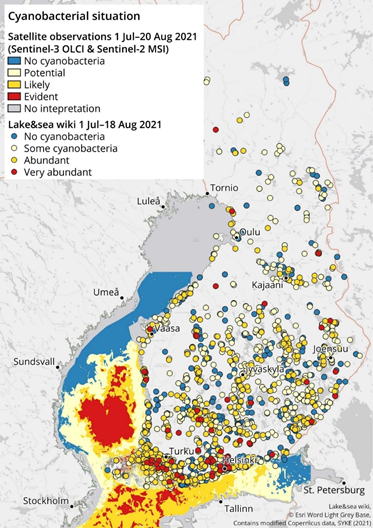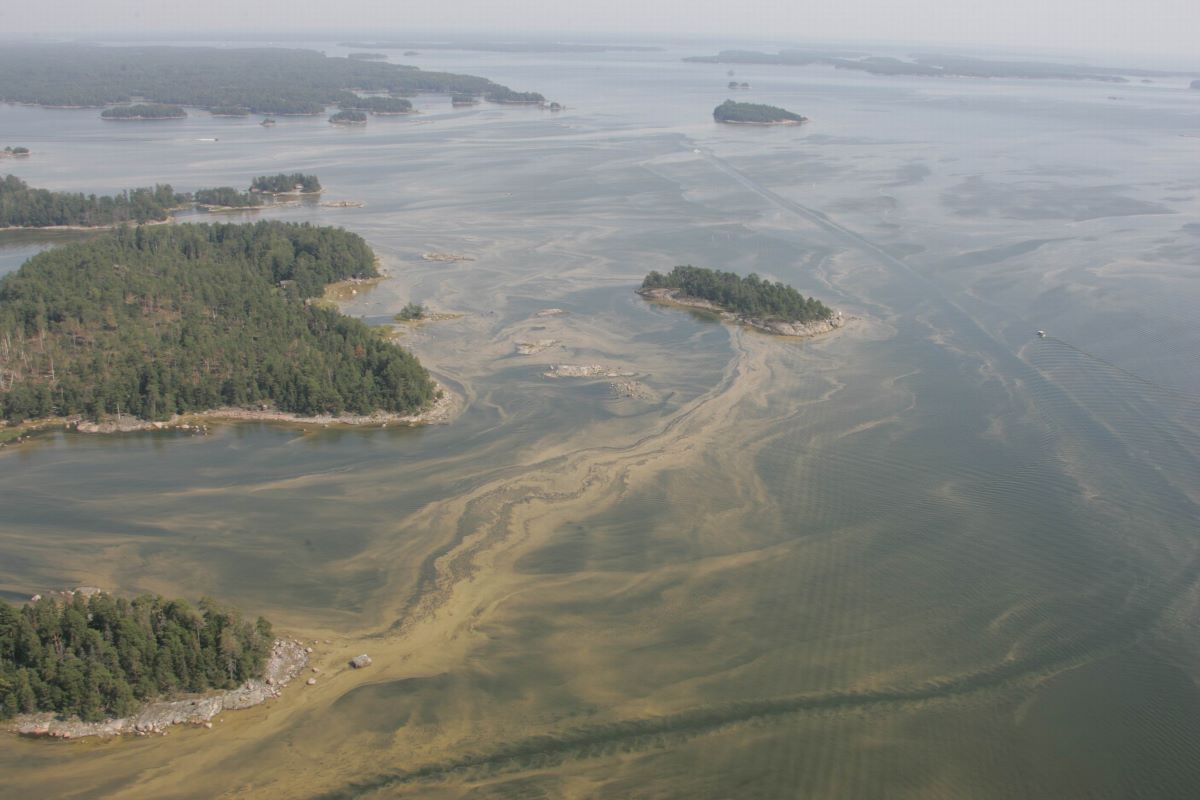Blooms of cyanobacteria occur practically every summer in the Baltic Sea, covering large areas of the sea during July-August, and having a substantial influence on ecosystem and marine services. That is why Finnish Environment Institute SYKE has published an extensive, weekly overview of cyanobacterial occurrence in Finnish inland waters and sea areas already since 1998.
The overview is based on monitoring of the state of the environment in collaboration between SYKE and several local authorities. The activity of some organizations has also significantly increased the number of observation points for cyanobacterial blooms, especially on the SW and S coasts of Finland. Today, the national cyanobacterial bloom monitoring network includes > 400 permanent observation sites around the country in, coastal areas, the archipelago, and inland waters.
The basic water monitoring is linked with bloom observations from satellites and, on the sea level, the Research Vessel Aranda and the Finnish Border Guard. The JERICO RI Gulf of Finland Pilot Supersite, especially the Alg@line ferrybox systems and the Utö Atmospheric and Marine Research Station – is essential in deriving high-frequency and real-time observations during the whole life cycle of the bloom. Real-time data of seawater surface temperature is provided by the Finnish Meteorological Institute FMI. SYKE and FMI together produce forecasts on drifting of cyanobacterial surface occurrences based on winds and currents.
Citizen science is an important element in the monitoring of cyanobacterial blooms. Individual citizens have been able to participate in the monitoring by sending their observations to an online service. Finally, communications on the cyanobacterial situation are always facilitated by fruitful collaboration between researchers and the media.
Summer 2021 was unusual

The blooms are primarily influenced by the availability of inorganic phosphorus and favoured by warm and calm weather (which we holiday-makers like too).
This year was different from the usual: despite the surplus phosphate after the spring bloom, extensive and long-lasting surface occurrences of cyanobacteria did not form in the Finnish offshore areas, except occasionally in the central Gulf of Bothnia. The amount of cyanobacteria in the Finnish coasts slightly peaked in mid-July due to the warm weather, but strong winds mixed the cyanobacteria in the water column soon afterwards. The biomasses were further reduced by a long-lasting upwelling of cold water to the surface.
The seawater has been unusually clear in many areas. Whether that is an anomaly or an indication of the improved state of the coastal waters, remains to be seen.
Data from high-frequency, (near) real-time observations can be seen in the links below: Cyanobacterial species composition, biomass and pigments were observed at the Utö Atmospheric and Marine Research Station, and the data are shown in the links below:
Phytoplankton species composition, measured with the FlowCytoBot imaging flow cytometer: http://swell.fmi.fi/Uto/ifcb/index.html
Cyanobacterial biomass: https://swell.fmi.fi/hab-info/graphs_biomass_1d.html
Phytoplankton pigment composition: https://swell.fmi.fi/hab-info/graphs_phytosturb_92d.html
Satellite observations in the TARKKA online service: www.syke.fi/tarkka/en
Alg@line ferrybox monitoring on merchant ships: https://www.marinefinland.fi/en-US/The_Baltic_Sea_now/Automatic_observations_from_ships
Team: Sirpa Lehtinen, Harri Kuosa, Jenni Attila, Jukka Seppälä, Kristiina Vuorio, Hanna Alasalmi
About the JERICO-S3 Pilot Supersites
JERICO-S3 will provide regionalised innovative monitoring and science strategies at 4 Pilot Supersites in The Gulf of Finland, the North-western Mediterranean, The North Sea and the English Channel and the Cretan Sea.
The Pilot Supersites (PSSs) will be established and tested during a short implementation period (January 2021 to August 2022) to demonstrate how transnationally and trans-institutionally integrated multidisciplinary and multiplatform observations add value to our ability to answer the multiple key scientific and social challenges that the coastal ocean is facing.

